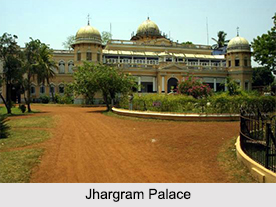 Jhargram Palace is located in Jhargram in the district of Paschim Medinipur. The palace"s structure is combined with the Italian and Islamic architecture model which exhibits an incorporation of Muslims and Gothic architectural styles. A large portion of its ground floor has been converted into a Heritage Hotel by the joint venture of Hotel Malladev Ltd and West Bengal Tourism Development Cooperation. The palace is situated amidst the inviting beauty of nature and lush greenery. Jhargram means a village surrounded by deep forests.
Jhargram Palace is located in Jhargram in the district of Paschim Medinipur. The palace"s structure is combined with the Italian and Islamic architecture model which exhibits an incorporation of Muslims and Gothic architectural styles. A large portion of its ground floor has been converted into a Heritage Hotel by the joint venture of Hotel Malladev Ltd and West Bengal Tourism Development Cooperation. The palace is situated amidst the inviting beauty of nature and lush greenery. Jhargram means a village surrounded by deep forests.
History of Jhargram Palace
Jhargram Palace was founded around 1592 AD by Sarveshwar Singh and his elder brother, the Generals under Man Singh of Amer and came to triumph over Bengal when Emperor Akbar granted Subehdari of Bengal, Bihar and Odisha to Raja Man Singh. Sarveshwar Singh was from the Chauhan clan of Rajputs from Fatehpur Sikri. He overpowered and defeated the local Mal tribal kings who were ruling the region known as Junglekhand. As remuneration Raja Man Singh settled mansabdari of the complete region of Junglekhand to his victorious generals Sarveshwar Singh Chauhan under the subordination as a branch vassal state to the Mughal Emperor Akbar.
Location of Jhargram Palace
Distance between Kolkata to Jhargram is 178 km by Road and 154 km by Rail. Jhargram, near Midnapore, is well known for the Jhargram Raj Palace.
Tourist spots in Jhargram Palace
The palace has turned out to be a heritage tourist spot where one of the prime attractions of this palace is the Radha Krishna Temple and another prominent attraction of this place is the Deer Park that is located 3 km away from Jhargram Town. Located between Jhargram and Lodhasuli is the Jungle Mahal which has a rose garden. The Sabitri Temple is also a well-liked attraction and has a naturally formed stone resembling Devi Sabitri. People can also visit the Kanak Durga Temple and the Chilkigarh Raj Palace, located around 12 km away from Jhargram.
Architecture of Jhargram Palace
The Main Building is remarkable. The Jhargram Raj Palace is a wealthy Italianate structure, set in carefully laid lawns and gardens. The palace was designed by the Calcutta Improvement Trust during the reign of Raja Narasingha Malla Deb Bahadur in 1931 CE.
As per the records, some dignitaries who have officially stayed in this palace are Lord Willingdon, the British Viceroy of India, Sir John Arthur Herbert- the Governor of Bengal, Lord Richard Casey- the Governor of Bengal, Prafulla Chandra Ghosh, Bidhan Chandra Roy, Lal Bahadur Sastri, Uttam Kumar, Pranab Mukharjee and Mamta Banerjee.
Jhargram Palace has recently set up a new joint venture with West Bengal Tourism to expand tourism communications and the heritage resort will embrace 15 twin cottages that will face two water bodies. There will be 30 rooms in all, a central dining hall-cum-cafeteria, conference room, museum, open green lawns, boating and a lily pool etc.



















